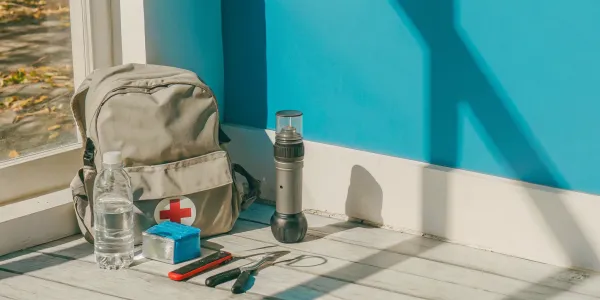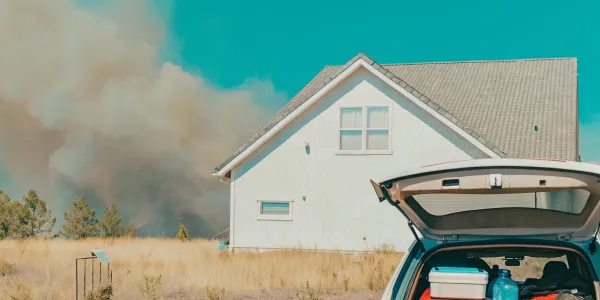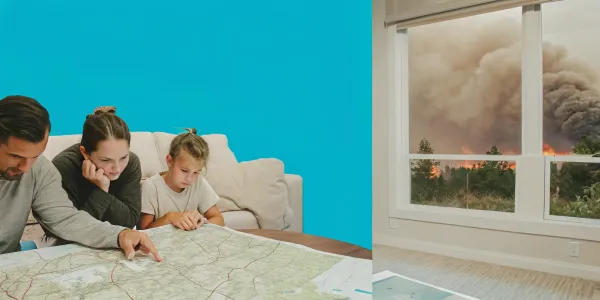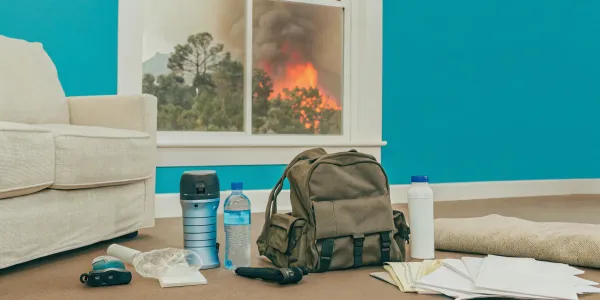What Are the 5 P's of Evacuation Packing? Your Checklist
Learn what are the 5 p's of evacuation packing and get a practical checklist to help you prepare your go-bag and protect your family in an emergency.
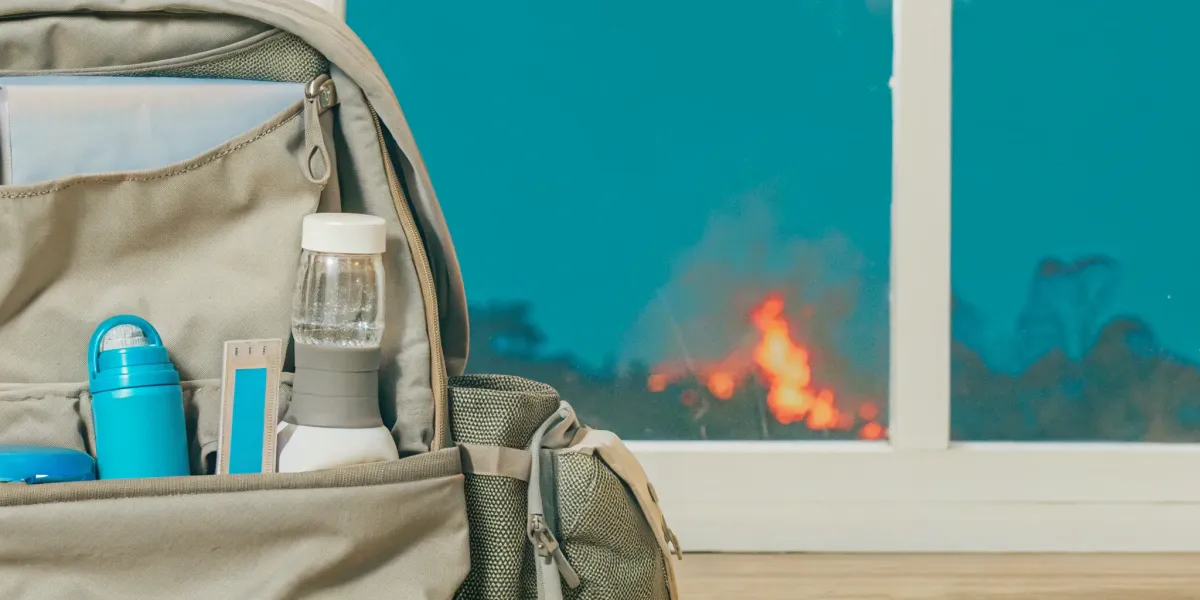
An evacuation isn't just about getting out safely; it's also about what comes next. The items you take with you can make a monumental difference in your ability to recover and rebuild. While your home and belongings can be replaced, your family, pets, health, and vital records cannot. This is why having a clear packing strategy is a core part of any solid wildfire action plan. By understanding what are the 5 P’s of evacuation packing, you create a system that prioritizes your immediate safety and your long-term recovery. This framework ensures you don’t leave behind the critical documents and personal items you’ll need to navigate the challenging days ahead.
Key Takeaways
- Prioritize Under Pressure with the 5 P's: Use this simple framework—People, Pets, Prescriptions, Photos, and Papers—to cut through the panic of an evacuation and focus on what's truly irreplaceable for your family's safety and recovery.
- A Go-Bag is More Than a Checklist: An effective kit is organized, easy to carry, and stored where you can grab it instantly. Set a calendar reminder to refresh food, water, medications, and batteries every six months so it's always ready.
- Turn Your Supplies into a Strategy: A go-bag is just a tool; a plan puts it to work. Ensure your family's safety by mapping and practicing multiple evacuation routes and establishing a clear communication plan for if you get separated.
What Are the 5 P's of Evacuation?
When an evacuation order is issued, panic can set in, making it nearly impossible to think clearly. You might have only minutes to leave your home, and in that high-stress moment, trying to decide what to take can be overwhelming. This is where a simple, memorable framework comes in. The 5 P’s of evacuation give you a mental checklist to run through, helping you prioritize the absolute essentials for your safety and recovery. It’s a concept that emergency responders have shared for years because it’s so effective.
Instead of frantically grabbing random items, this method provides a clear strategy when every second counts. It helps you focus on what truly matters, cutting through the chaos and giving you a concrete list to follow. Think of it as a critical part of your overall Wildfire Action Plan—a tool that turns a frightening moment into a series of manageable steps. By thinking through and preparing your 5 P's ahead of time, you can act decisively, reduce stress, and get your family to safety faster. This isn't just about packing a bag; it's about building a reflex that kicks in when you need it most, ensuring you don't leave behind something—or someone—truly irreplaceable.
Why This Simple Framework Works
In an emergency, your brain isn't wired for complex decision-making. Simple, repeatable plans are what get you through. The beauty of the 5 P's is its simplicity. It’s a straightforward memory aid that’s easy to recall even when you’re under immense pressure. The framework provides a clear hierarchy, forcing you to focus first on life and safety before moving on to items needed for recovery.
This prioritization is key. As experts at Backwoods Home Magazine explain, the "Five Ps" create an order of importance to guide your packing. This structure prevents you from wasting precious time debating whether to pack a sentimental sweater when you should be locating your family members or grabbing critical medications. It’s a proven method for staying focused on what will help you and your family get through the crisis and begin to rebuild afterward.
A Breakdown of Each "P"
To put this framework into action, let’s look at what each "P" represents. Having these items organized and ready to go in a designated "go-bag" can make your evacuation smoother and safer.
- People: Your family’s safety is the absolute top priority. Make sure every person in your household is accounted for and ready to leave. This includes having a designated meeting spot if you get separated.
- Pets: Your animals are part of the family and depend on you. Have their carriers, leashes, food, water, and any necessary medications packed and accessible. Never leave them behind.
- Prescriptions: Gather all necessary medications, eyeglasses, hearing aids, and other critical medical supplies. It’s wise to keep at least a week’s supply in your emergency kit.
- Photos: While most things can be replaced, personal photos hold irreplaceable memories. This could mean grabbing a small box of physical photos or a portable hard drive with your digital backups.
- Papers: These are the vital documents you will need to start rebuilding your life. This includes passports, birth certificates, social security cards, insurance policies, and property deeds. Keep physical copies in a waterproof bag and have digital backups stored securely online.
Your 5 P's Evacuation Checklist
When an evacuation order comes, you may only have minutes to leave. Trying to decide what to take under that kind of pressure is nearly impossible. That’s where the 5 P’s framework comes in. It’s a simple, memorable checklist that helps you prioritize the absolute essentials, ensuring you protect what matters most: your family, your health, and your ability to recover.
Think of this list as the core of your grab-and-go strategy. Building this into your Wildfire Action Plan ahead of time transforms a moment of panic into a series of clear, manageable steps. This framework helps you create a thorough wildfire preparedness checklist so you can act with confidence when every second counts.
People: Personal Must-Haves
Your family’s safety is the top priority. Each person should have a bag with personal items to last for at least 72 hours. This isn’t about comfort—it’s about health and safety. Pack a complete change of clothes, including socks and underwear, and a pair of sturdy, closed-toe shoes. Include basic toiletries, a cell phone with a portable power bank, and a small amount of cash, since power outages can make credit cards useless.
Also, create a physical list of emergency contacts and a designated family meeting place in case you get separated and cell service is down. Having these essentials ready means you can focus on getting everyone out the door safely, which is the most important step of all.
Pets: Essentials for Your Animals
Your pets are completely dependent on you during an emergency. Forgetting their needs can lead to heartbreaking situations. Prepare a dedicated go-bag for each animal in your home. This kit should include a sturdy leash or carrier, at least three days of food and bottled water, and collapsible bowls. Pack any medications your pet needs, along with a copy of their vaccination records—many emergency shelters require them.
It’s also wise to include a current photo of you with your pet to help prove ownership if you become separated. A favorite toy or blanket can reduce stress. Making a plan for your pets is a critical part of your family’s overall evacuation strategy, ensuring no one gets left behind.
Prescriptions: Critical Medical Supplies
In the chaos of an evacuation, leaving behind critical medical supplies can quickly become a life-threatening emergency. Your go-bag must include at least a seven-day supply of all prescription medications for every family member. Keep a waterproof list of each medication, its dosage, the prescribing doctor, and the pharmacy. Don’t forget other health necessities like eyeglasses, contact lenses and solution, hearing aids with extra batteries, and any essential medical equipment.
It’s also a good idea to pack a basic first-aid kit with over-the-counter pain relievers, bandages, and antiseptic wipes. Having these items organized and ready to grab ensures that a stressful situation doesn’t turn into a medical crisis.
Photos: Irreplaceable Memories
While insurance can help you replace your home and belongings, it can’t replace your family’s history. Photos, home videos, and personal keepsakes are invaluable. The best strategy is to prepare ahead of time. Spend a weekend scanning old photos and important mementos to create digital copies. You can digitize your family photos and save them to a cloud service and a password-protected external hard drive.
Keep that hard drive in your go-bag. If you have a few small, truly irreplaceable physical items like a wedding album or a child’s first drawing, store them together in a single, easy-to-grab box. This way, you can protect your most cherished memories without wasting precious seconds searching for them.
Papers: Vital Documents and Records
After a disaster, the documents you have will be the foundation for rebuilding your life. You will need them for everything from filing insurance claims to proving your identity. Gather your family’s vital records, including birth certificates, passports, social security cards, and marriage or divorce decrees. Also, collect property documents like deeds, vehicle titles, and your home insurance policy. Make copies of bank account and credit card information.
Like photos, the safest approach is to digitize these documents and store them securely. Keep physical copies in a waterproof, fire-resistant bag or box that you can grab quickly. Having these papers organized is a key part of creating an emergency financial first aid kit.
How to Build Your Go-Bag
Knowing what to pack is the first step, but how you assemble and store your go-bag is just as critical. A well-organized kit can save you precious minutes when an evacuation order comes. Building your go-bag is a proactive step that puts you in control. It’s about more than just checking items off a list; it’s about thoughtfully preparing for your family’s specific needs. By taking the time to choose the right storage, organize your supplies logically, and store your kit in a strategic location, you’re turning a source of anxiety into a concrete plan for safety.
Choose the Right Storage
Your go-bag's container needs to be durable, portable, and easy to manage under stress. Flimsy shopping bags won’t work when you need to move quickly. Instead, opt for sturdy backpacks for each family member, as they keep your hands free. Duffel bags or small, wheeled suitcases are also good options. The key is to choose something you can comfortably carry. As insurance provider Chubb suggests in its emergency evacuation packing list, you should "pack your items in crates or bags you can easily carry." Make sure the bag is large enough for essentials but not so big it becomes too heavy to lift into a car.
Keep It Organized
In an emergency, you won’t have time to dig through a jumbled mess to find a bandage or flashlight. A well-organized bag makes every item easy to find. Group similar items together using smaller pouches or labeled zip-top bags. You can create mini-kits within your main bag for categories like first aid, documents, toiletries, and electronics. This method keeps things tidy and allows you to grab exactly what you need without unpacking everything. A little organization now will save you a lot of stress later.
Decide Where to Store It
Your go-bag is useless if you can’t find it when you need it. Designate a specific, accessible spot for your kit and make sure everyone in the household knows where it is. Good locations include a coat closet near the front door or in the garage next to your primary vehicle. The ideal spot is cool, dry, and easy to get to on your way out. The federal government's preparedness site, Ready.gov, recommends you "keep your kit in a known spot, ready to grab if you need to leave quickly." Avoid storing it in a basement or attic where it might be difficult to reach.
Pack Your Kit the Smart Way
Knowing what to pack is one thing; packing it effectively is another. A well-organized go-bag can make a huge difference when minutes count. The goal isn’t just to have your supplies, but to have them in a way that’s accessible, portable, and tailored to your family’s specific needs. A disorganized, heavy bag can slow you down and add stress to an already tense situation. By thinking strategically about how you pack, you can ensure your kit is a tool for safety, not a burden. This means planning ahead, using space wisely, and choosing containers that you can actually manage in a hurry.
What to Pre-Pack Now
You can’t pack everything ahead of time, but you can get a significant head start. Begin by packing non-perishable items that you won’t need for daily life: copies of documents, extra batteries, a first-aid kit, and a change of clothes. For the items you’ll need to grab at the last minute—like medications, laptops, and your wallet—create a physical checklist. Keep this list with your go-bag. Some people even practice gathering their items to see how long it takes. This simple drill helps build muscle memory, so you can act quickly and confidently when an evacuation order comes.
Maximize Your Space
It’s tempting to pack for every possible scenario, but overpacking is a common mistake. An overstuffed bag is heavy, and it makes finding what you need nearly impossible. Instead of cramming everything in, focus on multi-use items and essentials. Use packing cubes or clear, labeled zip-top bags to group similar items together—one for toiletries, one for electronics, one for snacks. This keeps your gear organized and accessible. Remember, the goal is to evacuate safely, not to bring all your comforts with you. A streamlined kit is a more effective kit.
Pack for Easy Carrying
During an evacuation, you need to be mobile. Choose containers that you and your family members can carry without difficulty. Backpacks are an excellent choice because they keep your hands free. For heavier supplies that you might store in the garage, like bulk water or pet food, sturdy crates or bins with handles work well. Pack your items so the weight is distributed evenly. Assign bags to different family members based on their ability to carry them. The easier it is to grab your gear and go, the faster you can get on the road to safety.
Plan for Special Needs
Every household is unique, and your go-bag should reflect that. Think through the specific needs of every person and pet in your home. This includes packing enough food, water, and medications for everyone for several days. If you have an infant, you’ll need formula, diapers, and wipes. For older adults, include spare glasses, hearing aid batteries, and any necessary medical equipment. Don’t forget your pets—pack their food, water, leashes, and a carrier. Creating a personalized wildfire action plan can help ensure these critical, specific needs aren’t overlooked in a crisis.
Common Packing Mistakes to Avoid
Knowing what to pack is only half the battle. How you pack and where you keep your kit can make all the difference when you need to leave in a hurry. Even the most well-intentioned people make simple errors that can cause chaos during an evacuation. A little foresight now helps you avoid these common pitfalls, ensuring your go-bag is a source of support, not stress. By steering clear of these mistakes, you can be confident that your kit is practical, accessible, and ready for action when you need it most.
The Risk of Overpacking
When you’re thinking about a crisis, it’s tempting to pack everything you might possibly need. But an overstuffed bag can do more harm than good. A heavy, disorganized kit is difficult to carry and slows you down. More importantly, when your bag is crammed full, it becomes nearly impossible to find what you need quickly. Instead of being a source of preparedness, it becomes a source of frustration. The key is to focus on the essentials—the truly irreplaceable items that fit within the 5 P’s framework. Your goal is a lightweight, organized bag that you can grab and go without a second thought.
Forgetting Key Documents
In the rush to evacuate, it’s incredibly easy to forget the most important paperwork. Items like birth certificates, passports, social security cards, insurance policies, and property deeds are critical for recovery after a disaster. Trying to replace them can be a bureaucratic nightmare. To avoid this, gather your essential documents now. Make digital copies and save them to a password-protected USB drive or a secure cloud service. Keep the original documents or certified copies together in a waterproof and fire-resistant pouch inside your go-bag. This simple step ensures your vital records are protected and with you.
Storing Your Kit in the Wrong Place
A perfectly packed go-bag is useless if you can’t get to it when an evacuation order comes. Many people make the mistake of stashing their kits in an out-of-the-way place, like the back of a closet, the attic, or a cluttered garage. During an emergency, you won’t have time to dig for supplies. Your kit needs to be stored in a consistent, accessible location that every member of your household knows. A hall closet near your primary exit or the trunk of your car are excellent choices. The goal is to make grabbing your kit a simple, reflexive action on your way out the door.
Keep Your Kit Ready to Go
Building your go-bag is a huge step, but it’s not a one-and-done task. An evacuation kit is a living resource that needs attention to stay effective. Food expires, seasons change, and your family’s needs evolve. A well-maintained kit means that when an evacuation order comes, you can grab your bag with confidence, knowing everything inside is ready and relevant for the situation at hand. Think of it as a small investment of time now that pays off when every second counts.
Update Your Kit Regularly
Set a calendar reminder to check your kit at least once a year—every six months is even better. During this review, check the expiration dates on all food, water, medications, and batteries. Canned goods should be kept in a cool, dry place, while any boxed food needs to be in tightly sealed containers to protect it from pests. This is also the perfect time to review your kit against a master checklist and think about how your family’s needs have changed. Did someone start wearing glasses? Do you have a new baby who needs formula and diapers? Keeping your supplies current is critical.
Adjust for the Season
Wildfire season can bring a range of weather conditions, from scorching heat to cool, smoky nights. Your kit should reflect that. In the spring, swap out heavy winter coats for lightweight jackets and add sunscreen and extra water. As fall approaches, pack warmer layers, thermal blankets, and rain ponchos. Make sure your items are packed in sturdy bags or crates that you can carry easily. A seasonal check-in ensures you’re prepared for the elements you’re most likely to face if you have to leave your home.
Know When to Replace Items
Beyond expired food, other items need regular replacement. Test your flashlights and battery-powered radios and swap in fresh batteries. Review your paper documents—do you have the most recent copy of your insurance policy or bank statements? It’s also a good time to assess the condition of your gear. A leaky water bottle or a backpack with a frayed strap won’t do you any good in an emergency. Use this opportunity to streamline your bag. People often overstuff their kits, making them heavy and disorganized. A regular review helps you remove what you don’t need, making critical gear more accessible.
Turn Your Kit Into an Action Plan
Having a well-stocked go-bag is a critical first step, but it’s only half the battle. When smoke is on the horizon and evacuation orders are issued, panic can set in, making it hard to think clearly. A go-bag is a tool; an action plan is your guide for using that tool effectively. It transforms a collection of supplies into a coordinated response, ensuring that you and your family can act decisively when every second counts. Without a plan, even the best-packed kit can be forgotten or poorly utilized in the rush to get out.
Your plan turns chaos into a clear sequence of steps. It answers the crucial questions before you’re under pressure: Who grabs what? Which way do we go? How do we find each other if we get separated? Thinking through these scenarios now saves precious minutes when they count the most. It’s about building muscle memory for your family, so your emergency response becomes second nature. A solid plan doesn't just prepare you for the worst-case scenario; it gives you a sense of control in a situation that can feel overwhelmingly out of your hands. It’s the difference between reacting with fear and responding with confidence, ensuring your focus remains on what's most important: getting everyone to safety.
Decide What to Grab First
In the stress of an evacuation, it’s easy to forget what truly matters. To keep your priorities straight, use the simple "Five Ps" framework: People, Pets, Prescriptions, Photos, and Papers. This order is your mental checklist, ensuring you secure living beings and irreplaceable items before anything else. Your go-bag should already contain copies of important papers and extra prescriptions, but this framework reminds you to grab the originals, your pets, and most importantly, to make sure every person is accounted for. Thinking through this list ahead of time helps you create a grab ‘n’ go kit that truly serves your family’s immediate needs.
Map Your Evacuation Routes
When it’s time to leave, you can’t assume your usual route will be open. Wildfires can block roads unexpectedly, and traffic can bring everything to a standstill. That’s why you need to "know several ways to leave your home and practice them often with your family," as CAL FIRE advises. Identify at least two different escape routes from your neighborhood. Drive them at different times of day to understand potential bottlenecks. Keep physical maps in your car in case cell service or GPS fails. Practicing these routes removes the guesswork and helps everyone in your household feel more prepared and less anxious when an evacuation is necessary.
Set Up a Family Communication Plan
During an emergency, it’s common for families to get separated. Cell towers can become overloaded or damaged, making it difficult to connect with loved ones. To prepare for this, your family needs a communication plan. Designate one person who lives outside your immediate area to be the central point of contact. In an emergency, it’s often easier to make a long-distance call than a local one. Make sure everyone, including children, has this person’s number saved in their phone and written down in their go-bag. You should also establish a predetermined meeting spot—both near your home and outside your neighborhood—in case you can’t communicate. A complete wildfire action plan helps you organize all this information in one place.
Customize Your Kit for Your Family
A one-size-fits-all evacuation kit doesn’t really exist. Every household is unique, and your go-bag should reflect the specific needs of the people you live with. Thinking through these details now means you won’t be scrambling to find essential items when every second counts. Customizing your kit ensures everyone, from the youngest to the oldest, has what they need to be safe and as comfortable as possible during a stressful time.
This means considering the practical needs of children, the specific health requirements of seniors, and any medical equipment your family relies on. It also means packing small comfort items that can make a huge difference for morale. A well-thought-out kit is a powerful tool that shows you’ve planned for everyone’s well-being.
Packing for Children
Evacuations can be especially frightening for children. Giving them a small sense of control can help ease their anxiety. Pack a small, lightweight backpack for each child with their own essentials. Include a change of clothes, sturdy shoes, and a familiar comfort item like a favorite stuffed animal, book, or small toy. This not only ensures they have what they need but also gives them something familiar to hold onto. Involving them in packing their bag can also be a gentle way to talk about emergency preparedness without causing unnecessary fear.
Essentials for Seniors
Older adults often have specific needs that must be addressed in an evacuation kit. Pack non-perishable food that meets their dietary requirements, such as low-sodium or soft options, along with extra bottled water. Include a complete list of their medications, dosages, and doctors' contact information. If they use mobility aids like a cane or walker, make sure it’s stored near the go-bag for a quick grab. It’s also wise to pack an extra pair of prescription glasses and any hearing aids with spare batteries, as these are easy to forget in a rush.
Including Medical Equipment
For anyone in your household who relies on medical supplies, these items are non-negotiable. Your kit should contain at least a week’s supply of all necessary prescription medications. Don’t forget over-the-counter items you use regularly, like pain relievers or allergy medicine. If you rely on equipment like a blood sugar monitor, an inhaler, or a portable oxygen machine, ensure they are packed with all necessary supplies, including chargers or extra batteries. A complete wildfire action plan should always account for these critical health needs.
Adding Items for Comfort
While survival essentials are the priority, don’t underestimate the power of comfort during a crisis. Being displaced is exhausting and emotionally draining. Packing a few small items can provide a sense of normalcy and relief. Think about basic personal hygiene items like a toothbrush, toothpaste, deodorant, and soap. A portable phone charger or power bank can be a lifeline for staying connected with loved ones and receiving updates. A book, a deck of cards, or a small notebook and pen can also help pass the time and reduce stress while you wait.
Related Articles
Frequently Asked Questions
This all feels overwhelming. Where should I even begin? Start with the 5 P’s framework. Before you buy a single supply, just think through those five categories: People, Pets, Prescriptions, Photos, and Papers. Make a simple list for each one. This approach breaks a huge task into manageable pieces and helps you focus on what is truly irreplaceable. Once you have that list, gathering the items feels much more achievable.
How much food and water do I really need to pack? The standard recommendation is to have at least a three-day (72-hour) supply of non-perishable food and water for each person and pet in your household. For water, that means one gallon per person, per day. Choose ready-to-eat foods that don't require cooking or refrigeration, like protein bars, dried fruit, and nuts. The goal is to have enough to sustain you until you can get to a shelter or other accommodations.
What's the single biggest mistake people make with their go-bags? The most common mistake is overpacking. It’s tempting to try and save everything, but a go-bag that’s too heavy to carry quickly becomes a liability. It slows you down and makes it impossible to find what you need in a hurry. Focus on the essentials for health, safety, and recovery. A streamlined, organized kit you can actually grab and carry is far more effective than a massive suitcase you can barely lift.
My go-bag is packed and ready. Does that mean I'm done? Packing your kit is a fantastic and critical first step, but it's not the final one. Your go-bag is a tool, and you need a plan for how to use it. This means mapping out at least two evacuation routes, establishing a family communication plan, and deciding on a meeting place. A complete Wildfire Action Plan ensures that when it's time to leave, everyone knows exactly what to do, where to go, and how to stay in touch.
What if I have to leave immediately and haven't prepared a kit? If an evacuation order comes and you have nothing packed, stay calm and run through the 5 P's as a mental checklist. First, account for all People and Pets. Next, grab all Prescriptions and medical necessities. Then, grab your wallet, phone, and keys—these cover your most critical Papers and identification. Finally, if you have a few seconds to spare, grab your laptop or a single box of irreplaceable Photos. The absolute priority is getting out safely.

